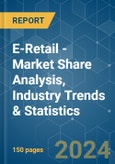The E-Retail Market size is estimated at USD 6.27 trillion in 2024, and is expected to reach USD 8.48 trillion by 2029, growing at a CAGR of 6.23% during the forecast period (2024-2029).
The market was impacted by COVID-19 as the travel restrictions were increased. However, after the restrictions were lifted, the market witnessed growth as many people started ordering from online websites. In today's world, the best way to capture consumers' attention and wallet share is to provide seamless, vibrant shopping experiences that go across channels. Today's shoppers have broadly adopted the convenience of shopping online so much that online retail sales continue to grow in double digits, while 'brick-and-mortar' retail sales are either in low single digits or are receding. As a result, retailers are making significant reserves to capitalize on the chance to increase market share and revenues. These investments in e-commerce and related digital capabilities can be improved by targeting new markets around the world.
E-commerce is expected to become the largest retail channel in the world over the forecast period, outpacing sales through retail outlets, such as supermarkets, independent grocers, and apparel and footwear retailers, among others. Global retail e-commerce sales recorded a steady growth of more than 6%. This growth was largely influenced by the Asia-Pacific. In the digitally maturing markets of Central and Eastern Europe, as well as parts of Southeast Asia, e-commerce accounted for less than 5% of the retail sales. The same was true for regions where economic factors had slowed down the e-commerce sales growth, such as Latin America and the Middle East and Africa.
This product will be delivered within 2 business days.
The market was impacted by COVID-19 as the travel restrictions were increased. However, after the restrictions were lifted, the market witnessed growth as many people started ordering from online websites. In today's world, the best way to capture consumers' attention and wallet share is to provide seamless, vibrant shopping experiences that go across channels. Today's shoppers have broadly adopted the convenience of shopping online so much that online retail sales continue to grow in double digits, while 'brick-and-mortar' retail sales are either in low single digits or are receding. As a result, retailers are making significant reserves to capitalize on the chance to increase market share and revenues. These investments in e-commerce and related digital capabilities can be improved by targeting new markets around the world.
E-commerce is expected to become the largest retail channel in the world over the forecast period, outpacing sales through retail outlets, such as supermarkets, independent grocers, and apparel and footwear retailers, among others. Global retail e-commerce sales recorded a steady growth of more than 6%. This growth was largely influenced by the Asia-Pacific. In the digitally maturing markets of Central and Eastern Europe, as well as parts of Southeast Asia, e-commerce accounted for less than 5% of the retail sales. The same was true for regions where economic factors had slowed down the e-commerce sales growth, such as Latin America and the Middle East and Africa.
Online Retail Market Trends
Increasing Internet Penetration Driving the Market
E-commerce is expected to become the largest retail channel in the world, accounting for 14% of the total retail sales, outpacing sales through retail outlets, such as supermarkets, independent grocers, and apparel and footwear retailers, among others. The growth of the e-commerce sector is expected to be supported by rising internet penetration and smartphone use. Consumer preferences shift toward online buying as the internet and cell phones become more widely used. Online retail is growing due to the increasing usage of smartphones and tablets worldwide. People can shop on their phones owing to technological advancements such as branded shopping apps, 5G wifi, and social shopping. On several e-commerce platforms, brands count on virtual shopping and experimenting with augmented and virtual reality retail. Consumers have no limits in the metaverse, a 3D virtual reality. People from all across the world can engage with products in a metaverse, irrespective of their location.Consumers Buying Fashion Online Driving the Market
Fashion is the second-largest retail category after grocery. The shift toward e-commerce is a significant, palpable movement in most economies. A quarter of spending on clothing, accessories, and footwear (fashion) already occurs online, and it is still rapidly growing. The penetration rate of buying fashion online is roughly twice that of the overall retail sales. Online marketplaces, like Amazon, are key purchase influencers in a fashion shopper's purchase journey. Shoppers are spending more time on websites to discover and research products, providing retailers with insights into buyers' purchase decisions. Innovations such as artificial intelligence and machine-learning tools allow retailers to leverage this wealth of consumer data toward responsive design and better product recommendations.Online Retail Industry Overview
The report provides an overview of the major international players operating in the e-retail market. Currently, some of the major players are dominating the sector in terms of revenue share. However, minor companies (mid-size and small) are focusing on improving their presence by securing new contracts and entering new markets. Some key players include eBay, Alibaba Group Holdings Ltd, Walmart Inc., JD.com Inc., and Amazon Inc.Additional Benefits:
- The market estimate (ME) sheet in Excel format
- 3 months of analyst support
This product will be delivered within 2 business days.
Table of Contents
1 INTRODUCTION
4 MARKET DYNAMICS AND INSIGHTS
5 MARKET SEGMENTATION
6 COMPETITIVE LANDSCAPE
Companies Mentioned (Partial List)
A selection of companies mentioned in this report includes, but is not limited to:
- Amazon Inc.
- eBay
- Alibaba Group Holding Ltd
- JD.Com Inc.
- Flipkart
- Ikea
- Walmart Inc.
- Zalando
- Groupon Inc.*
Methodology

LOADING...










